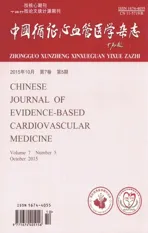第二代药物洗脱支架治疗局灶型和非局灶型支架内再狭窄疗效比较
2015-01-22张惠芳宋洪勇赵林周建军郭成军
张惠芳,宋洪勇,赵林,周建军,郭成军
• 论著 •
第二代药物洗脱支架治疗局灶型和非局灶型支架内再狭窄疗效比较
张惠芳,宋洪勇,赵林,周建军,郭成军
目的比较第二代药物洗脱支架治疗局灶型和非局灶型支架内再狭窄病变的临床结局。方法入选2011年1月~2013年3月在首都医科大学附属北京安贞医院心内科因药物洗脱支架支架内再狭窄(DES-ISR)接受第二代药物洗脱支架(DES)治疗的患者254例,男性201例,女性53例。所有患者根据支架内再狭窄(ISR)病变造影类型分为局灶型组(87例)和非局灶组(167例)。所有患者随访2年,比较两组主要不良心血管事件(MACEs,包括心源性死亡、心肌梗死和靶病变血运重建等)发生情况,分析术后靶病变血运重建(TLR)的危险因素。结果非局灶型患者B2/C型病变比例明显高于局灶型(69.5% vs. 41.4%),病变长度和支架长度均高于局灶型患者,为[(25.46±3.38)mm vs. (8.13±2.21)mm]、[(28.59±11.25)mm vs. (19.47±7.09)mm],差异有统计学意义(P均<0.01)。非局灶组MACEs发生率明显高于局灶组(38.3% vs. 24.1%),TLR明显高于局灶组(32.3% vs. 18.4%),差异均具有统计学意义(P均<0.05)。COX回归分析发现,非局灶ISR是TLR的独立危险因素(OR=2.134,95%CI:1.173~3.884)。Kapan-Meier生存曲线显示,局灶型患者接受第二代DES治疗术后2年内TLR生存率高于非局灶型患者(P=0.024)。结论第二代DES治疗DES-ISR时,局灶型ISR患者预后优于非局灶型ISR患者。
第二代药物洗脱支架;支架内再狭窄;局灶型;非局灶型;靶病变血运重建
虽然冠状动脉介入技术已有很大进步,但支架内再狭窄(in-stent restenosis,ISR)仍是当今具有挑战性的难题,尤其对于复杂病变患者[1,2]。目前最常用的治疗策略是药物洗脱支架(DES),随着第二代DES出现,显著降低了ISR的发生率[3,4]。许多临床和介入因素均可影响ISR再次介入治疗的结局,其中ISR造影类型是一项重要因素。许多研究已经证实ISR类型可预测接受经皮冠状动脉腔内成形术(PTCA)、金属裸支架(BMS)、第一代DES以及冠状动脉旁路移植术(CABG)治疗后再次血运重建的发生[5-8]。另有研究显示第二代DES与BMS、第一代DES及
其他治疗方法比较更加安全有效[4]。但目前尚未见有关第二代DES治疗ISR术后结局与ISR类型的相关报道。
因此,本研究旨在探讨第二代DES治疗DESISR术后主要不良心血管事件(MACEs)的发生率,进一步比较不同ISR类型对DES-ISR再次置入DES术后的影响。
1 资料与方法
1.1 研究对象和分组入选2011年1月~2013年3月在首都医科大学附属北京安贞医院心内科因DES-ISR接受第二代DES治疗的患者254例,男性201例,女性53例。所有患者根据ISR病变造影类型分为局灶型再狭窄组即局灶组(87例)和非局灶型再狭窄组即非局灶组(167例)。入选标准:首次经DES治疗后临床无创检查(常规心电图、平板运动试验或心肌核素显像检查)获得复发心肌缺血证据,经冠状动脉造影检查发现既往置入支架ISR(病变狭窄≥50%)并再次置入第二代DES治疗。排除标准:既往行冠状动脉旁路移植术(CABG)的患者;曾经多次行DES置入的患者;曾经短期化疗治疗患者;支架内血栓患者;恶性肿瘤;患有其他疾病期望寿命<12个月;对药物(雷帕霉素或紫杉醇)过敏患者。
1.2 冠状动脉影像学检查经桡动脉或股动脉造影,常规体位投照,取多部位造影,并用冠状动脉造影定量分析(QCA)软件分析病变特点。患者接受第二代DES,包括依维莫司药物支架(EES,Xience V,Abbott Vascular,Santa Clara California)和佐他莫司药物支架(ZES,Resolute,Medtronic Inc.)。Mehran等[8]于1999年提出ISR的造影分型方法:Ⅰ型是局灶型,病变长度<10 mm;Ⅱ型为弥漫支架内型,病变长度>10 mm,但在支架内,未超出支架边缘;Ⅲ型为弥漫增生型,病变长度>10 mm,超出支架边缘;Ⅳ型为完全闭塞型,TIMI血流等级为0。本研究在上述分型基础上将Ⅰ型定义为局灶型病变,Ⅱ、Ⅲ、Ⅳ型定义为非局灶型病变。根据美国心脏病学会/美国心脏病协会(ACC/AHA)[10]的病变分类将靶病变分为A、B1、B2、C型。病变特征包括:成角,迂曲,中-重度钙化,分叉,开口病变。支架特征包括:支架数目、支架长度及支架直径。
1.3 随访术后采用电话随访或来院复查的方式获得患者2年内MACEs情况,包括临床靶病变血运重建(TLR),心肌梗死(MI),死亡。TLR定义为因缺血需要再次行外科或介入血运重建,其主要包括两个方面:有缺血体征和症状,血管狭窄≥50%;无缺血症状,血管狭窄≥70%。
1.4 统计学方法所有数据分析均采用SPSS 17.0软件。计量资料采用均数±标准差(±s)表示,两组间均数的比较采用t检验,计数资料采用例数(构成比)表示,组间比较采用χ2检验。应用Kaplan-Meier法比较两组TLR生存率,应用Cox回归比例风险模型计算相对危险度,P<0.2的相关因素(ISR类型、糖尿病、分叉病变和支架长度)进入COX回归模型。P<0.05为差异有统计学意义。
2 结果
2.1 两组患者基本资料比较两组年龄、性别、高血压、糖尿病、高脂血症、吸烟、心肌梗死病史、疾病类型比例及药物使用方面比较,差异无统计学意义(P均>0.05)(表1)。
2.2 冠状动脉造影及介入治疗情况两组患者在病变血管、开口病变、成角、中重度钙化、分叉病变、再次DES特征、支架数目、支架直径方面比较,差异均无统计学意义(P均>0.05)。非局灶型患者B2/C型病变比例明显高于局灶型(69.5% vs. 41.4%),病变长度和支架长度均高于局灶型患者,为[(25.46±3.38)mm vs. (8.13 ±2.21)mm]、[(28.59±11.25)mm vs. (19.47 ±7.09)mm],差异有统计学意义(P均<0.01)(表2)。
2.3 长期随访结果及术后TLR的COX回归模型分析随访期间,非局灶组死亡3例(1.8%),局灶组2例(2.3%);非局灶组发生心肌梗死7例(4.2%),局灶组3例(3.4%)。非局灶组MACEs发生率明显高于局灶组(38.3% vs. 24.1%),TLR明显高于局灶组(32.3% vs. 18.4%),差异均有统计学意义(P均<0.05)(表3)。COX回归分析发现,非局灶ISR是TLR的独立危险因素(OR=2.134,95%CI:1.173~3.884)(表4)。
Kapan-Meier生存曲线显示,局灶型患者接受第二代DES治疗术后2年内TLR生存率高于非局灶型患者(P=0.024)(图1)。
3 讨论
冠状动脉介入术发展经历了PTCA、BMS和 DES置入三座里程碑。再狭窄的发生从BMS时20%~30%降到DES时的10%左右。ISR的治疗策略包括:单纯球囊扩张(POBA)、切割球囊扩张(CBA)、再次置入药物洗脱支架(DES)以及支架内放射治疗等[14]。但目前最佳的治疗策略尚不明确,其中认为再次置入DES可以取得更好的效果[15]。随着第二代DES的问世,使得DES在治疗ISR方面优势更加显著[3,4]。许多研究已经证实ISR类型可预测接受PTCA、BMS、第一代DES以及CABG治疗后再次血运重建的发生[5-8]。但目前未见有关第二代DES治疗ISR术后结局与ISR类型的相关性报道。
研究表明ISR造影类型与后续再介入治疗效果有关[5-8]。Mehran等[8]于1999年提出ISR的造影分型方法,并发现根据ISR类型不同,再次介入治疗术后血运重建发生率不同:Ⅰ型(局灶型,19%),Ⅱ型(弥漫型,35%),Ⅲ型(增生型,50%),Ⅳ型(完全闭塞行,83%)。弥漫型ISR与局灶型ISR比较,新生内膜增生更加明显。另外,弥漫型ISR成功接受介入治疗后,TLR发生率高达85%[5,7,12,13]。上述研究中治疗策略包括PTCA、BMS、第一代DES以及CABG[7]。最近有关研究表明第二代DES用于治疗DES-ISR时,比DES和BMS更加安全有效[3,4]。SPIRIT Ⅲ[16]研究发现依维莫司(EES)支架晚期管腔丢失仅0.16 mm,这远远小于SIRIUS study[17]研究紫杉醇药物支架(SES)的0.19 mm。另一项研究称EES支架较其他支架的管壁更薄,其用于治疗ISR和小血管病变时,可降低ISR和临床不良事件的发生[18]。
本研究中所有患者均接受了再次第二代DES治疗。随访2年中,非局灶型病变患者和局灶型病变患者TLR发生率为32.3%和18.4%。本研究首次比较了第二代DES治疗不同类型ISR术后长期随访结果的差异。另外COX回归分析还发现非局灶型ISR是再次支架置入术后TLR的独立危险因素。
很多研究已报道了ISR的相关危险因素[19,20]。糖尿病患者新生内膜增生显著、斑块负荷重,易发生血管重塑,已经证实其ISR发生率明显增加[19]。这些患者多为弥漫型ISR,另外长支架(C型病变)、多支架术后也易发生弥漫型ISR。本研究中非局灶组长病变和B2/C型病变比例明显高于局灶组,与以往研究一致[20,21]。另外先前研究还证实糖尿病与BMS术后发生非局灶型ISR明显相关[22]。无论DES还是BMS,支架术后最小管腔直径均是ISR重要的预测因子。
本研究提示,第二代DES治疗DES-ISR安全有效,但用于治疗非局灶型ISR时MACEs发生率
高于局灶型ISR。非局灶型ISR是第二代DES治疗DES-ISR术后发生TLR的独立危险因素。
[1] Cosgrave J,Melzi G,Corbett S,et al. Comparable clinical outcomes with paclitaxel- and sirolimus-eluting stents in unrestricted contemporary practice[J]. J Am Coll Cardiol,2007,49(24):2320-8.
[2] Ardissino D,Cavallini C,Bramucci E,et al. Sirolimus-eluting vs uncoated stents for prevention of restenosis in small coronary arteries: a randomized trial[J]. JAMA,2004,292(22):2727-34.
[3] Yamashita K,Ochiai M,Yakushiji T,et al. Repeat drug-eluting stent implantation for in-stent restenosis: first- or second-generation stent[J]. J Invasive Cardiol,2012,24(11):574-8.
[4] Almalla M,Schröder JW,Pross V,et al. Three-year follow-up after treatment of bare-metal stent restenosis with first-generation or second-generation drug-eluting stents[J]. Coron Artery Dis, 2013,24(2):165-70.
[5] Yokoi H,Kimura T,Nakagawa Y,et al. Long term clinical and quantitative angiographic follow-up after Palmaz-Schatz stent restenosis[J]. J Am Coll Cardiol,1996,27(Suppl A):224A.
[6] Reimers B,Moussa I,Akiyama T,et al. Long-term clinical followup after successful repeat percutaneous intervention for stent restenosis[J]. J Am Coll Cardiol,1997,30(1):186-92.
[7] Alfonsos F,Perez-Vizcayno MJ,Hernandez R,et al. Long term outcome and determinants of event-free survival in patients treated with balloon angioplasty for in-stent restenosis[J]. Am J Cardiol,1999, 83(8):1268-70.
[8] Mehran R,Dangas G,Abizaid AS,et al. Angiographic patterns of in-stent restenosis: classification and implications for long-term outcome[J]. Circulation,1999,100(18):1872-8.
[9] Stone GW,Ellis SG,Cox DA,et al. A polymer-based, paclitaxeleluting stent in patients with coronary artery disease[J]. N Engl J Med,2004,350(3):221-31.
[10] Alfonso F,Cequier A,Angel J,et al. for the RIBS Investigators. Value of the American College of Cardiology/American Heart Association angiographic classification of coronary lesion morphology in patients with in-stent restenosis. Insights from the Restenosis Intra-Stent Balloon Angioplasty Versus Elective Stenting (RIBS) randomized trial[J]. Am Heart J,2006,151(3):681e1-e9.
[11] Freed FS,Safian RD. Proximal vessel tortuosity and angulated lesions[M]. Manual of Interventional Cardiology,3rd edition,Physician’s Press,2001:237-43.
[12] Mehran R,Abizaid A,Mintz G,et al. Patterns of in-stent restenosis: classification and impact on subsequent target lesion revascularization[J]. J Am Coll Cardiol,1998,31(Suppl A):141A.
[13] Nibler N,Kastrati A,Elezi A,et al. Angiographic and clinical followup of patients with asymptomatic restenosis after coronary stent implantation[J]. J Am Coll Cardiol,1998, 31(Suppl A):65A.
[14] Costa MA. Treatment of drug-eluting stent restenosis[J]. Am Heart J,2007,153:447-9.
[15] Kim YH,Lee BK,Park DW,et al. Comparison with conventional therapies of repeated sirolimus-eluting stent implantation for the treatment of drug-eluting coronary stent restenosis[J]. Am J Cardiol, 2006,98(11):1451-4.
[16] Turco MA,Ormiston JA,Popma JJ,et al. Reduced risk of restenosis in small vessels and reduced risk of myocardial infarction in long lesions with the new thin-strut TAXUS Liberté stent: 1-year results from the TAXUS ATLAS program[J]. JACC Cardiovasc Interv,2008, 1(6):699-709.
[17] Stone GW,Midei M,Newman W,et al. Randomized comparison of everolimus-eluting and paclitaxel-eluting stents: two-year clinical follow-up from the clinical evaluation of the Xience V everolimus eluting coronary stent system in the treatment of patients with de novo native coronary artery lesions (SPIRIT) III trial[J]. Circulation,2009, 119(5):680-6.
[18] Weisz G,Leon MB,Holmes DR Jr,et al. Two-year outcomes after sirolimus-eluting stent implantation: results from the sirolimuseluting stent in de novo native coronary lesions (SIRIUS) trial[J]. J Am Coll Cardiol,2006,47(7):1350-5.
[19] Kornowski R,Mintz G,Kent K,et al. Increased restenosis in diabetes mellitus after coronary intervention due to exaggerated intimal hyperplasia[J]. Circulation,1997,95(6):1366-9.
[20] Kastrati A,Schomig A,Elezi S,et al. Predictive factors of restenosis after coronary stent placement[J]. J Am Coll Cardiol,1997,30(6):1428-36.
[21] Hoffman R,Mintz GS,Dussaillant GR,et al. Pattern of in-stent restenosis: a serial intravascular ultrasound study[J]. Circulation, 1996,94(6):1247-54.
[22] Park CB,Park HK. Predictors of diffuse-type in-stent restenosis following drug-eluting stent implantation[J]. Exp Ther Med,2013,5(5):1486-90.
Comparison in curative effects of second-generation drug-eluting stent in treatment of focal-type and non-focal-type in-stent restenosis
ZHANG Hui-fang*, SONG Hong-yong, ZHAO Lin, ZHOU Jian-jun, GUO Cheng-jun.*Sixth Department of Cardiology, Beijing Anzhen Hospital, Capital University of Medical Sciences, Beijing 100029, China. Corresponding author: SONG Hong-yong, E-mail: byhongyong2007@163.com
ObjectiveTo compared the clinical outcomes of focal-type in-stent restenosis (ISR) and nonfocal-type ISR treated with second-generation drug-eluting stent (DES).MethodsThe patients (n=254, male 201 and female 53) undergone second-generation DES due to DES-ISR were chosen from Jan. 2011 to Mar. 2013. All patients were divided into focal-type ISR group (n=87) and non-focal-type ISR group (n=167) according to the outcomes of angiography. The patients were followed up for 2 y, the incidence of major adverse cardiovascular events [MACE, including cardiac death, myocardial infarction and target lesion revascularization (TLR)] were compared in 2 groups, and risk factors of TLR were analyzed after treatment.ResultsThe percentage of patients with B2/C lesion was significantly higher (69.5% vs. 41.4%), and lesion duration [(25.46±3.38) mm vs. (8.13±2.21) mm] and stent length [(28.59±11.25) mm vs. (19.47±7.09) mm] were higher in non-focal-type ISR group than those in focal-type ISR group (all P<0.01). The incidence of MACE (38.3% vs. 24.1%) was significantly higher and TLR (32.3% vs. 18.4%) was significantly higher in non-focal-type ISR group than those in focal-type ISR group (all P<0.01). COX regression analysis showed that non-focal-type ISR was an independent risk factor of TLR (OR=2.134, 95%CI: 1.173-3.884). Kapan-Meier survival curve showed that the survival rate of TLR was higher in focal-type ISR group than that in non-focal-type ISR group within 2 y after undergone second-generation DES (P=0.024).ConclusionWhen applying second-generation DES for treating DES-ISR, the prognosis is better in patients with focal-type ISR than that in patients with non-focal-type ISR.
Second-generation drug-eluting stent; In-stent restenosis; Focal-type; Non-focal-type; Target lesion revascularization
R816.2
A
1674-4055(2015)05-0659-04
2015-05-14)
(责任编辑:姚雪莉)
100029 北京,首都医科大学附属北京安贞医院心内六科(张惠芳,赵林,周建军,郭成军);中国人民解放军第306医院心内科(宋洪勇)
宋洪勇,E-mail:byhongyong2007@163.com
10.3969/j.issn.1674-4055.2015.05.23
